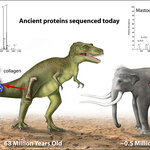Science category landing
Life Sciences
Well, I have previously started an "Open Evolution" series here and now I am starting an "Open Metagenomics" series. I know, I have gotten grief from some out there (yes, you Rob Edwards - see comments here) about my support for somewhat non-open things in metagenomics, so I am going to try and make up for that as much as possible.
In the first installment, I am pointing people to a new paper on PLoS Genetics "Trends in Selenium Utilization in Marine Microbial World Revealed through the Analysis of the Global Ocean Sampling (GOS) Project" by Yan Zhang, Vadim N. Gladyshev (hat tip to Katie…

A fascinating story in the New York Times today on kin recognition in plants (see Plants Found to Show Preferences for Their Relatives ).
They report
The sea rocket, researchers report, can distinguish between plants that are related to it and those that are not. And not only does this plant recognize its kin, but it also gives them preferential treatment.
And
Dodder is unable to grow its own roots or make its own sugars using photosynthesis, the process used by nearly all other plants. As a result, scientists knew that after sprouting from seed, the plant would fairly quickly need to begin…

Cameron Alexander and George Pasparakis at the University of Nottingham have been able to facilitate a conversation between bacterial cells and artificial polymer vesicles by way of sugar groups on the vesicle surface.
For an organism to develop and function, the individual cells must exchange information, or communicate, with each other. Is it possible to learn their language and "talk to" the cells?
Apparently so. In the journal Angewandte Chemie Alexander and Pasparakis report that this first communication occurred by way of sugar groups on the vesicle surface. The vesicles subsequently…

Maize, commonly called corn in the US, is the third most important cereal in the world. It has a great number of advantages for molecular agriculture such as its capacity to express recombinant proteins in the seeds, its widespread cultivation and its genetic diversity, along with being anti-allergenic and non-toxic.
Now scientists from the Universidad de Lleida (University of Lleida) have published a study (1) confirming that maize seeds are an effective and sure platform within molecular agriculture to alleviate diseases. Over the next few years AIDS could be one of the first diseases to…

St. Jude Children's Research Hospital investigators have found that an electrically powered amplification mechanism in the cochlea of the ear is critical to the acute hearing of humans and other mammals. The findings will enable better understanding of how hearing loss can result from malfunction of this amplification machinery due to genetic mutation or overdose of drugs such as aspirin.
Sound entering the cochlea is detected by the vibration of tiny, hair-like cilia that extend from cochlear hair cells. While the cochlea’s “inner hair cells” are only passive detectors, the so-called “outer…

The ability to regenerate lost body parts is unevenly distributed among higher organisms. Among vertebrates, some amphibians are able to replace lost limbs completely, while mammals are unable to regenerate complex appendages.
The only exception to this rule is the annual replacement of deer antlers.
The annual regrowth of these structures is the only example of regeneration of a complete, anatomically complex appendage in a mammal, and antlers are therefore of high interest to regeneration biologists.
The epimorphic regeneration of appendages may involve progenitor cells created through…

Nitric oxide has emerged as an important signaling molecule in plants - as in mammals including people. In studies of a tropical medicinal herb as a model plant, researchers have found that nitric oxide targets a number of proteins and enzymes in plants.
In collaborative work with the research group of Renu Deswal, a faculty member, and her doctoral student at the Botany Department, University of Delhi, India, Agricultural Research Service (ARS) scientist Autar Mattoo has identified 19 such targeted proteins and enzymes in Kalanchoe pinnata, also known as "miracle leaf."
These proteins and…

Researchers have mapped out a region on human chromosome 1 that contributes to genetically elevated blood triglyceride levels, a major risk factor for heart disease.
Triglycerides (TG), the main form of dietary fat, continuously circulate in the blood, but if their concentration elevates the risk of atherosclerosis and subsequently heart disease increases. Circulating TG levels depend on many factors including diet, exercise, and smoking, but around 40% of the variation in the population is due to genetics.
To locate the genes contributing to increased TG levels, Qing Wang and colleagues…

Tests of the peptide sequences in T. rex bone fossils have put more meat on the theory that dinosaurs' closest living relatives are modern-day birds.
Molecular analysis, or genetic sequencing, of a 68-million-year-old Tyrannosaurus rex protein from the dinosaur's femur discovered in 2003 by paleontologist John Horner of the Museum of the Rockies confirms that T. rex shares a common ancestry with chickens, ostriches, and to a lesser extent, alligators.
The new research results represent the first use of molecular data to place a non-avian dinosaur in a phylogenetic tree, a "tree of life," that…

Score one for the nurture side of the nature vs. nurture debate, as North Carolina State University geneticists have shown that environmental factors such as lifestyle and geography play a large role in whether certain genes are turned on or off.
By studying gene expression of white blood cells in 46 Moroccan Amazighs, or Berbers – including desert nomads, mountain agrarians and coastal urban dwellers – the NC State researchers and collaborators in Morocco and the United States showed that up to one-third of genes are differentially expressed due to where and how the Moroccan Amazighs live.…